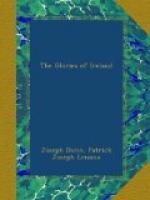LAND LAW. The entire territory was originally, and always continued to be, the absolute property of the entire clan. Not even the private residence of a clansman, with its maighin digona = little lawn or precinct of sanctuary, within which himself and his family and property were inviolable, could be sold to an outsider. Private ownership, though rather favored in the administration of the law, was prevented from becoming general by the fundamental ownership of the clan and the birthright of every free-born clansman to a sufficiency of the land of his native territory for his subsistence. The land officially held as described was not, until the population became numerous, a serious encroachment upon this right. What remained outside this and the residential patches of private land was classified as cultivable and uncultivable. The former was the common property of the clansmen, but was held and used in severalty for the time being, subject to gabhail-cine (gowal-kinneh)—clan-resumption and redistribution by authority of an assembly of the clan or fine at intervals of from one to three years, according to local customs and circumstances, for the purpose of satisfying the rights of young clansmen and dealing with any land left derelict by death or forfeiture, compensation being paid for any unexhausted improvements. The clansmen, being owners in this limited sense, and the only owners, had no rent to pay. They paid tribute for public purposes, such as the making of roads, to the flaith as a public officer, as they were bound to render, or had the privilege of rendering—according to how they regarded it—military service when required, not to the flaith as a feudal lord, which he was not, but to the clan, of which the flaith was head and representative.
The uncultivable, unreclaimed forest, mountain, and bog-land was common property in the wider sense that there was no several appropriation of it even temporarily by individuals. It was used promiscuously by the clansmen for grazing stock, procuring fuel, pursuing game, or any other advantage yielded by it in its natural state.
Kings and flaiths were great stock-owners, and were allowed to let for short terms portions of their official lands. What they more usually let to clansmen was cattle to graze either on private land or on a specified part of the official land, not measured, but calculated according to the number of beasts it was able to support. A flaith whose stock for letting ran short hired some from a king and sublet them to his own people. A feine, aithech, or ceile (kailyeh), as a farmer was generally called, might hire stock in one of two distinct ways: saer-"free”, which was regulated by the law, left his status unimpaired, could not be terminated arbitrarily or unjustly, under which he paid one-third of the value of the stock yearly for seven years, at the end of which time what




